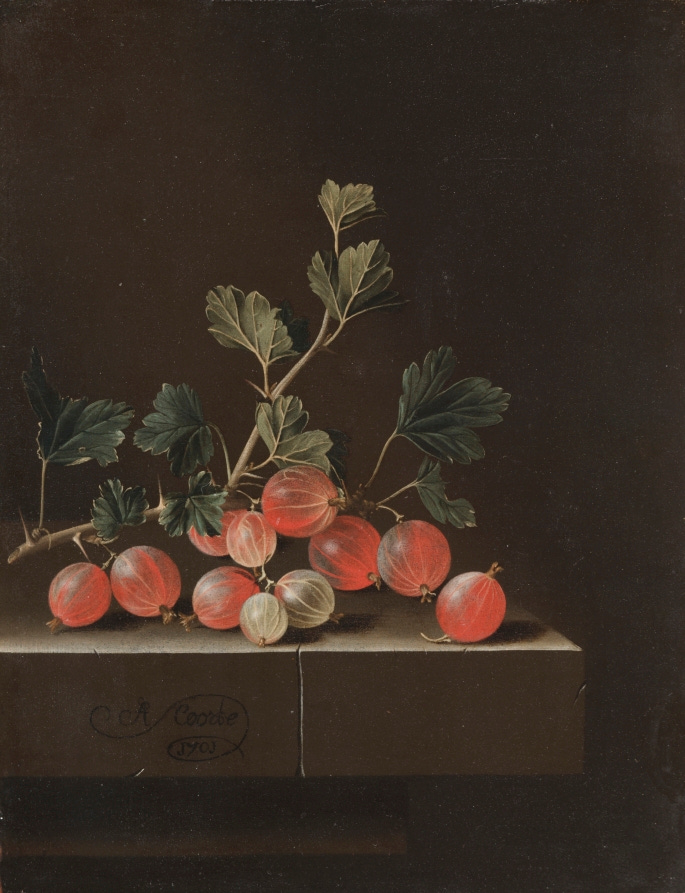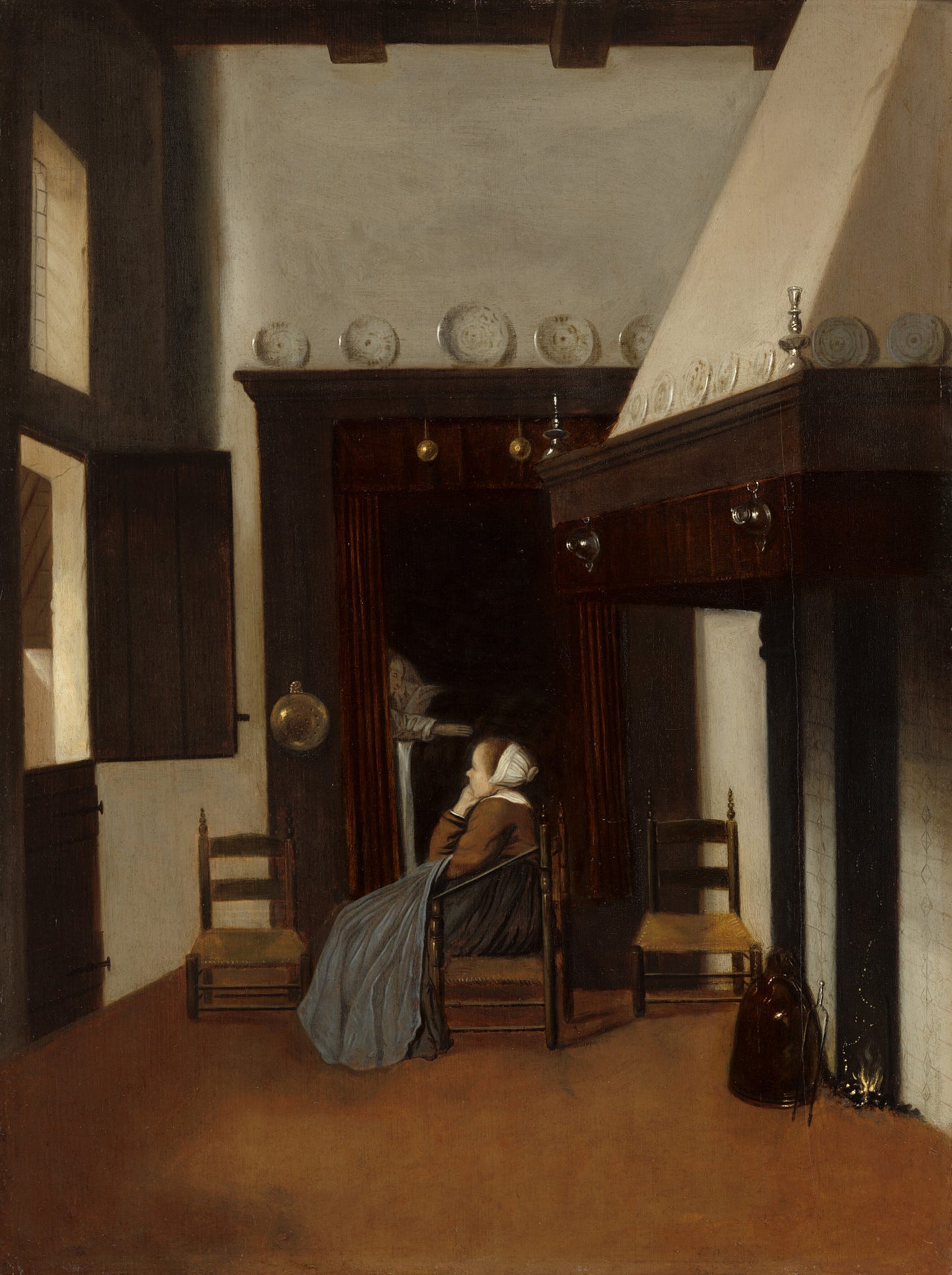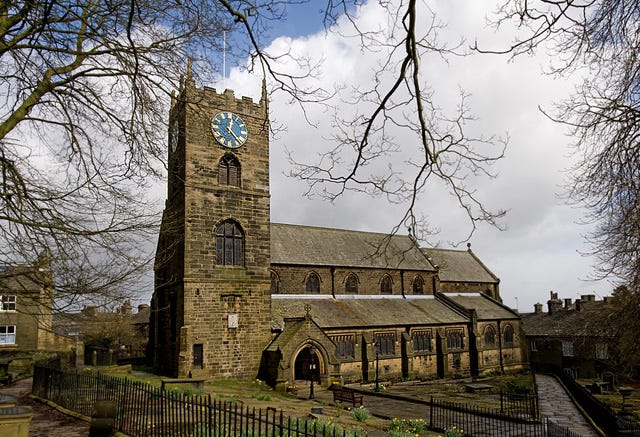Hello! Welcome to Week One of our Wuthering Heights read-along…
This week’s assignment is Volume I: Chapters I through III (1-3)
Characters: Mr. Lockwood, Heathcliff, Joseph, a number of the dogs who live at Wuthering Heights, Zillah, Hareton and Cathy.
So, What Happens In Chapters I-III?
We meet our first narrator: Mr. Lockwood. Lockwood, seeking respite from ‘the stir of society,’ leases Thrushcross Grange, and in Chapter I, takes it upon himself to walk to Wuthering Heights to introduce himself to his landlord, Mr. Heathcliff.
He is rebuffed by Heathcliff’s servant Joseph, gently mauled by Heathcliff’s dogs and rescued by Heathcliff’s housekeeper. Yet, the following day he returns.
We begin to become accustomed to Joseph’s dialect. We meet Hareton Earnshaw. And snow begins to pile up outside. Lockwood is momentarily left alone with young Cathy, and thoroughly embarrasses himself by mistaking dead rabbits for kittens. He shares a tense meal with the mismatched members of Heathcliff’s family and then witnesses witchcraft and ‘mock malignity’ aimed at a ‘scandalous old hypocrite.’
Finally, he is ushered to bed by Zillah, the stout housewife. There, inside the confines of a box bed once owned by Catherine Earnshaw, he dreams of religious zealotry and is visited by a ghost. And so our story begins…
‘I have just returned from a visit to my landlord…’
Despite his initial belief that he’d found a kindred spirit in the man he describes as, ‘more exaggeratedly reserved’ than himself, by the end of Chapter III, Lockwood’s opinion of Heathcliff has changed considerably.
Lockwood, while not stern and morose like Heathcliff, whose ‘black eyes withdraw so suspiciously under their brows,’ believes the two are identical in their mutual desire to seek a situation, ‘so completely removed from the stir of society.’ While waxing on his many similarities to Heathcliff he tells readers he has mistakenly earned a reputation of deliberate heartlessness (due to his snail-like demeanor). As a reader, this episode is a bit confusing. Suddenly thrust from the Heights, readers are at the seaside with Mr. Lockwood, ‘enjoying a month of fine weather.’ Shy dismissal of a young lady’s smile is viewed as dispassion. Brontë subtly reminds us of the world from which Lockwood comes—she reminds us of the social order.
Lockwood, who has foisted himself onto the Heights without invitation, soon labels Joseph as sour, dismisses Hareton as a clown, and considers Heathcliff, unmannerly. Despite her equally rustic demeanor, Lockwood views young Cathy through an upper middle-class lens. Knowing no other alternative for her situation he frames her in a role with which he’s familiar, he assumes she is either Heathcliff’s or Hareton’s wife.
The wonderful Welsh essayist Stevie Davies makes a most accurate observation of Lockwood in her, Emily Brontë, The Artist as a Free Woman (1983):1
Anyone can see that the Heights is a rough place, anyone including Lockwood: he does not acknowledge it at first because he does not want to. Its reality defies both his expectations and the social order which serves him as a survival plan.

Lockwood survives a tussle with Heathcliff’s ‘herd of possessed swine’ and in the end, shares a glass of wine with his landlord and deems Heathcliff, ‘very intelligent on the topics we touched.’ Maybe the two aren’t so different after all?
It’s what happens when he meets Catherine that distinguishes him from Heathcliff. But first, let’s talk about that snowstorm…
‘My Knuckles Tingled and the Dogs Howled’
Mr. Lockwood has recently leased Thrushcross Grange, and Brontë further shares the season of year by letting us know, ‘yesterday afternoon set in misty and cold.’
When the novel begins we are told it is 1801—if I’d not read a number of annotated editions of the story I would not necessarily know it is customary in England to lease property at Michaelmas. Michaelmas, a Christian festival and quarter day2 honoring St. Michael, Gabriel and Raphael, was traditionally observed on 11 October (now, 29 September).
The completion of the agricultural year, Michaelmas marked the end of one and beginning of another husbandman’s year - the turning point of the farming cycle, as harvest reaches its peak. Rents & debts were paid, new leases taken, positions filled.
Kristin Haakenson, Hearthstone Fables
When Lockwood visits the Heights, once again calling on Heathcliff, he describes a ‘four mile walk,’ to the garden gate, where he arrives just in time to escape the ‘first feathery flakes of a snow shower.’
On that bleak hilltop the earth was hard with a black frost, and the air made me shiver through every limb. Being unable to remove the chain, I jumped over, and running up the flagged causeway bordered with straggling gooseberry bushes, knocked vainly for admittance till my knuckles tingled and the dogs howled (Volume I: Chapter II).

A black frost is a killing frost. Brontë wants readers to know it is cold—very cold. Anyone who understands the natural world knows Lockwood should not have made the journey north to visit his landlord. A city-dweller, he is neither familiar with the natural world nor capable of understanding the inhabitants of the Heights’ ‘churlish inhospitality.’34
His second visit proves more aggravating.
Lockwood learns from Joseph that Heathcliff is down at the sheepfold. You see, he recognizes what sort of weather is on the horizon. Heathcliff is tending to animals. Lockwood is seeking society. By this chapter’s end, Lockwood is snowed-in at the Heights. And, what is always so evident to me every time I read this chapter is how Heathcliff places more value on the well-being of the myriad livestock, than he does, the safety and good-health of his tenant.
Heathcliff directs Hareton to, ‘Drive those dozen sheep into the barn porch,’ further explaining, ‘They’ll be covered if left in the fold all night.’ To secure his valuable stock, he adds, ‘and put a plank before them.’ At the same time, Joseph instinctively knows to bring in a pail of porridge for the dogs. As Lockwood openly panics at his inability to find his way back to the Grange, Hareton offers to, ‘go with him as far as the park.’ Heathcliff growls, ‘You’ll go with him to hell!’ clarifying, ‘…who is to look after the horses, eh?’
Livestock come first. Lockwood, second. They are commodities to Heathcliff.
‘A Large Oak Case, With Squares Cut Out Near the Top’
Heathcliff must preserve the life of Lockwood. He cannot send him out into the storm, lest he lose a tenant (e.g. rent). Heathcliff—we’ll also come to learn—functions within the law. He will not be charged with any sort of negligence in regard to the death of a man. After a skirmish with some dogs, and a pail of icy cold water splashed down his neck, Lockwood is permitted to remain overnight. Heathcliff directs his housekeeper, Zillah, to furnish a glass of brandy to their guest and then, he is ushered to bed.
When first I read Wuthering Heights, I had only the 1992 Peter Kosminsky film images in my head. I love the setting, costumes, furniture and cast of the Kosminsky film; I confess: Ralph Fiennes is my Heathcliff. There is this awkward thing about the film, though. The box bed scene. While I love Kosminsky’s furnishings, I’m always kind of disappointed in the box bed scene. Maybe I compare it to too many of the Lockwood book illustrations?
Plus, Fiennes is a thirty-year-old playing an adolescent boy. Weird, right? I digress.
You see, there is this intriguing piece of furniture called a box bed. In Brontë’s novel she calls it a large oak case—but the way it is described—it is certainly a box bed.
When Mr. Lockwood is ushered to an upstairs bedroom by Zillah in Chapter III, he enters, fastens the door and looks around. He spies a large oak case and investigates.

“Having approached this structure,” he explains, “I looked inside, and perceived it to be a singular sort of old-fashioned couch, very conveniently designed to obviate the necessity for every member of the family having a room to himself. In fact, it formed a little closet, and the ledge of a window, which it enclosed, served as a table.”
The box bed has been a fixture in this bedroom for years—and it once belonged to the Earnshaw’s daughter, Catherine. Not the Cathy whom Mr. Lockwood met downstairs; Catherine Earnshaw is the daughter of the late Mr. and Mrs. Earnshaw, recent owners of the Heights. You might remember the name Hareton Earnshaw above the door?
As you’re reading this passage you’re likely remembering Zillah escorting Lockwood upstairs and telling him to extinguish his candle. ‘Her master had an odd notion about the chamber…and never let anybody lodge there willingly.’ Brontë is teasing readers with gothic elements but she’s strewing those elements among scenes of domesticity and agrarian life. Outside, a winter storm is raging. Inside, only Heathcliff.
Lockwood is slipping through oak paneled doors, climbing inside with his candle and pulling them together again, ‘secure against the vigilance of Heathcliff and everyone else.’ Once sheltered inside, he discovers mysterious scrawling—names carved into the sill of the window and, between the pages of mildewed and musty books, he finds the diarying and marginalia of a young girl.
Inside the pages of the New Testament, we meet two more characters: Hindley and Frances. And an unhappy plough-boy, too. Lockwood begins to, ‘decypher her faded hieroglyphics.’ This is when we meet another of our narrators—Catherine Earnshaw.5
Lockwood has read the characters carved into the windowsill—Catherine Earnshaw, Catherine Heathcliff, Catherine Linton. He’s discovered a Testament with the words: ‘Catherine Earnshaw, her book, and a date some quarter of a century back,’ written inside. Now, he discovers a caricature of Joseph and a sad tale written by a little girl who has seemingly lost her father. Her father (his whereabouts are unknown to Lockwood) has been replaced by someone named Hindley, ‘a detestable substitute.’ This Hindley (and his wife Frances) force Catherine, Heathcliff and the unhappy plough-boy to attend some sort of quasi-church service in Calvinist Joseph’s garret while the two of them ‘do anything’ but read their Bibles downstairs. It is raining, and so they cannot attend church, it seems.
After a damp and chilly three hour church service led by vinegar-faced Joseph, they are liberated and Catherine and Heathcliff ‘[make themselves] as snug as [their] means allowing in the arch of the dresser.’ Catherine hangs up their pinafores as a curtain and Joseph immediately tears them down and complains to Hindley, saying the children are being disrespectful to the ‘just buried’ master. Ah! We now understand.
Catherine Earnshaw’s father—Joseph’s master—is recently deceased. But, we wonder, who is Hindley? Catherine’s diary certainly paints a terrible image of him—one, which includes atrocious treatment of Heathcliff. Catherine shares her sorrow in the margins of her Bible while the two are banished to the back-kitchen. Not Heathcliff. He—we’ll learn—is happy anywhere, as long as he’s with Catherine. He suffers no sorrow at the hands of Hindley, he proposes a plan. He knows where to seek refuge.
‘My companion is impatient and proposes that we should appropriate the dairy woman’s cloak, and have a scamper on the moors, under its shelter. A pleasant suggestion…’
The final entry read in Catherine’s pre-adolescent script includes evidence Catherine and Heathcliff followed through with their plan. Hindley called Heathcliff a vagabond and permanently banished him from the family dinner table. This initiates the novel’s tragic action.6
It is now that we (and Lockwood!) are most certainly forming our questions: Who is Hindley? Is Heathcliff a brother of Catherine’s? If Joseph is in service at the Heights and Heathcliff is his master, is he not an Earnshaw? Why the surname Heathcliff?
‘How I Writhed , and Yawned, and Nodded, and Revived!’
Was your attention lost while reading the next ten or so paragraphs of Chapter III—perhaps even, your eyes ‘began to nod drowsily?’ You are not alone.
Picking up Wuthering Heights, we all expect to be immersed in a moorland romance from cover-to-cover. Instead, we are guided by a snobby tourist, met by a surly man, groused at by his servant, mauled by his dogs and left wondering, who are those two young people living with the morose guy and why are they all begrudgingly living together? And just as we (and Lockwood) are introduced to twelve-year-old diarist Catherine Earnshaw, we are thrust into a detailed dream (filled with Brontë’s satiric commentary on religion), in which Lockwood attends a sermon with Joseph.
I confess, I only began to understand the perceived purpose of these paragraphs after searching in footnotes and poring over research dedicated to Emily Brontë’s thoughts pertaining to religion. As Lockwood describes his dream of faith and sin and the fear of excommunication, he and his dream-mate, the vinegar-faced Joseph, attend a fiery sermon preached by the fictional Jabes Branderham7, author of a fictional text found by Lockwood inside Catherine’s box bed.
Lockwood is wearing on our nerves with his peevishness. Where is the romance? When do we ramble the windswept moors? If not for this intriguing gothic (and olfactory) hook, we might entirely skip this dreamed episode:
‘We came to the chapel. I have passed it really in my walks, twice or thrice; it lies in a hollow, between two hills—an elevated hollow, near a swamp, whose peaty moisture is said to answer all the purposes of embalming on the few corpses deposited there.’
Again, to understand Joseph, Lockwood, and a church in which the dead are pungent, I consult my beloved Emily Brontë, The Artist as a Free Woman. Stevie Davies writes:
As Emily Brontë was writing, she could see the Church of St. Michael and All Angels from her window; it was her father’s church, and the church of her fathers.
Inside, the unhealthy edifice, the decomposing dead endured underfoot, aromatically present to the nostrils of the congregation. It was an area of deliberate darkness and breathless air, where the injunctions not to sin; the nasty consequences of sin; the doctrine of our bad beginnings, our errant journey and our sorry end were reiterated every Sunday.8
Anyone who reads about Emily Brontë learns she abstained from attending church. Catherine Earnshaw (via Lockwood’s narration) has shared (in her diarying) disdain for religious rigor and her description of Heathcliff’s desire to run away with her to the moors shows us his spiritual ideal.
Do you agree, moments before Lockwood begins to become weary, so too, do you? Brontë recognizes this and she parallels her readers’ collective frustration with his…
‘Oh, how weary I grew. How I writhed, and yawned, and nodded, and revived! How I pinched myself, and rubbed my eyes, and stood up, and sat down again, and nudged Joseph to inform me if he would ever be done!’
It’s at this moment, we are roused out of our stupor. We—and Lockwood—awake in the box bed, a fir tree rattling its cones against our window panes. It’s now we learn Heathcliff is not the savage, but perhaps, Lockwood.
‘Terror Made Me Cruel’
Lockwood is rattled. Maybe we are a bit, too? What has happened to Lockwood so far is like nothing we can really imagine—in 2025, we are so far removed from 1801, much of what Lockwood has seen, heard and experienced is unfamiliar to many of us.
When he wakes in the oak closet, hearing gusty wind, the driving of snow, and the ‘fir-bough repeat its teasing sound,’ he is compelled to silence it. Frustrated to discover he cannot unhasp the casement he strikes the glass, stretches his arm out and attempts to grasp the branch!
“I must stop it, nevertheless!” I muttered, knocking my knuckles through the glass, and stretching an arm out to seize the importunate branch: instead of which, my fingers closed on the fingers of a little, ice-cold hand!
The intense horror of nightmare came over me; I tried to draw back my arm, but the hand clung to it, and a most melancholy voice sobbed—
“Let me in—let me in!”
Would you agree, this episode certainly grabs readers’ attention? Lockwood has met with the hand of a ghost-child. He is struggling to free himself from her grasp, crying, “Who are you?” and we are wondering, is this a dream or is this reality?
“Catherine Linton,” it replied, shiveringly…“I’m come home, I’d lost my way on the moor!”
Lockwood recognizes the apparition as a child, yet he inflicts violence upon it:
As it spoke, I discerned, obscurely, a child’s face looking through the window—Terror made me cruel; and, finding it useless to attempt shaking the creature off, I pulled its wrist on to the broken pane, and rubbed it to and fro till the blood ran down and soaked the bedclothes: still it wailed, “Let me in!” and maintained its tenacious gripe9, almost maddening me with fear.
This scene is oft-illustrated; I’ve yet to find an illustration of the blood and gore which is (in a dream state) inflicted by Lockwood, this genteel visitor to the Heights. Having rifled through Catherine’s private diaries, slid between her sheets, Lockwood has now inflicted a sort of violence on her—a pre-adolescent child.
Again, I share the astute observation of Stevie Davies:
It is vigorous, purposeful, continuous. Heathcliff never does anything so shocking. Lockwood, daintily taking tea and mouthing only the most neutral conversation, could never have been imagined as performing an act of violence, or dreaming an interesting dream.
After we’re assured Lockwood was merely having a dream, we wonder why did Brontë include this scene? Davies believes Brontë is making a statement about human nature in general. The shocking behavior of Lockwood, “who as narrator mediates between [the characters’] inner reality and our outer reality,” permits readers to, “[play] out our fears and desires, across the threshold of conscious inhibition or taboo.”10
When we read Wuthering Heights we dream awake.
Stevie Davies, Emily Brontë, The Artist as a Free Woman
Much of what we believe we would not say, do or, even, think—the inhabitants of the Grange and the Heights think it, do it and certainly, say it! In fact, when Lockwood attracts the attention of Heathcliff with his outcry, Heathcliff does not mince words.
He arrives in Catherine’s bedroom, “in his shirt and trousers, with a candle dripping over his fingers, and his face as white as the wall behind him,” to the creaking of the oak box bed. After Lockwood confesses it was he who screamed out in his sleep, his landlord immediately utters threatens to sack whoever put him in there. The situation is further complicated and anger stoked, when Lockwood begins berating Catherine.
“If the little fiend had got in at the window, she probably would have strangled me!” he tells Heathcliff, finally calling her a “little minx,” “a changeling,” and a “wicked little soul!”
Heathcliff explodes, thundering, “What can you mean by talking in this way to me!” Did you notice, though, his anger immediately dissolves into grief? It’s this glimpse at Heathcliff’s grief which piques Lockwood’s interest in learning his landlord’s story—these first three chapters and the final three chapters are bookends to The Story of Heathcliff.
What’s Next?
When I sat down to begin writing this week’s summary I wasn’t sure where to begin!
I could talk about nearly every sentence in Wuthering Heights, analyzing its meaning, Brontë’s word choices, her sentence structure; I could write and write and write. I’m always going to omit something for lack of space and time. Please feel free to bring up any points of discussion you deem worthwhile in the Comments section. And, discuss amongst yourselves—you needn’t wait for my input.
I do hope this essay helped you get your bearings—remember, a number of additional resources—including character profiles—are found on the main Read With Me page.
Next week’s assignment includes four chapters (Volume I: Chapters IV-VII). We’ll meet our second unreliable narrator, Ellen “Nelly” Dean; she’ll detail for Lockwood (and, us!) events spanning from 1771 to 1777. We will learn how Catherine Earnshaw and Heathcliff relate and we’ll follow them into early-adolescence. ♡
Davies, Stevie. Emily Brontë, the Artist as a Free Woman. Carcanet, 1983.
Four days traditionally taken as the beginning or end of the four quarters of the year, often for purposes of charging rent. In England, Wales, and Northern Ireland they are Lady Day (25 March), Midsummer Day (24 June), Michaelmas (29 September), and Christmas Day (25 December). In Scotland they are Candlemas (2 February), Whitsuntide (15 May), Lammas (1 August), and Martinmas (11 November). Oxford Reference
Churlish means rude, unfriendly and unpleasant. Cambridge Dictionary
Elizabeth Gaskell wrote in her, The Life of Charlotte Brontë: There is little display of any of the amenities of life among this wild rough population [of Haworth]. Their accost is curt; their accent and tone of speech blunt and harsh.
Our only reliable narrator, as these are her private diaries.
Brontë, Emily, and Charlotte Brontë. The Annotated Wuthering Heights. Edited by Janet Gezari, The Belknap Press of Harvard University Press, 2014.
Rev. Jabes Branderham is said to be based on Rev. Jabes Bunting a fanatical Methodist leader in the Halifax area (page, 57, The Oxford Companion to The Brontës).
Davies, Stevie. “In at the Window,” pg. 119.
Emily Brontë uses this variant spelling of grip multiple times in the novel.
Davies, Stevie. “These Straining Eyes,” pages 87-88.







What a superb introduction to this hugely complex novel. I love the fact that you are so enraptured by the writing that you say you could write something about practically every word: it is a wealthy text, indeed, and the opening section has so much going on in it. There are multiple classic Gothic tropes, but so much else, too. Emily Bronte's writing can, I think, be pretty confusing when we first encounter it and, like many truly great texts, can only be fully comprehended after multiple readings, but we all have to start somewhere, and a guided reading is an excellent way to begin.
I love the images you're including in these posts!